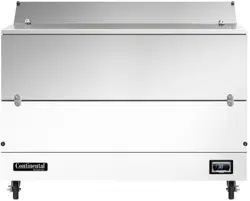Loading ...
Loading ...
Loading ...

7
OPERATIONS MANUAL
MILK COOLERS FORCED AIR & COLD WALL
START-UP PROCEDURE
ELECTRICAL CONNECTIONS
To insure proper operation, your new model must be connected
to an individual circuit that can supply the full voltage as stated
on the cabinet serial data plate. For correct voltage, power draw,
and wire accommodations, check the data on the serial data
plate located on the inner right wall of your new model. Verify
that this information exactly matches the electrical character-
istics at the installation location. An electrical wiring diagram,
located on the inside compressor compartment rear, next to
the electrical console box, should also be consulted during
connection. For reference, a copy of each electrical wiring dia-
gram is located towards the back of this manual (see “Wiring
Diagrams” section).
Refrigeration compressors are designed to operate within
+/-10% of the rated voltage indicated on the cabinet serial
plate. Excessively high or low supply power can burnout the
compressor. This can be easily detected and will void the fac-
tory warranty. Full voltage at the correct rating, on a separate,
designated circuit, not affected by the operation of other electri-
cal appliances, must be available to the refrigeration unit at all
times. Extension cords should never be used on commercial
equipment, as they can overheat and/or result in low voltage.
GFI/GFCI RECEPTACLES
Ground-Fault Circuit Interrupter (GFCI or GFI) devices are not
recommended for most commercial refrigerators and freez-
ers, since nuisance trips may occur, typically due to moisture.
This can cause temporary loss of power, which may result in
high storage temperatures and potentially unsafe food product.
Building codes in some areas may require certain 115 volt
receptacles to be protected by a GFI If you need to connect your
equipment to a protected circuit, a properly sized, commercial
grade GFI circuit breaker should be used on a separate, isolated
power supply. Or a qualified electrician may be able to hard wire
your equipment, eliminating the need for a GFI device. Contact
Continental’s Service Department before making any modifica-
tions to your cabinet, to avoid loss of warranty.
NOTE: GFI RECEPTACLES ARE NOT RECOMMENDED,
PRODUCT LOSS OR SERVICE PROBLEMS RESULTING
FROM NUISANCE TRIPS, CONNECTION TO A DEFECTIVE
OR IMPROPER POWER SUPPLY, AND UNAUTHORIZED
MODIFICATIONS TO YOUR EQUIPMENT CAN CAUSE A
HAZARD AND WILL VOID FACTORY WARRANTY.
REMOVAL OF TOP ASSEMBLY (Forced Air Models Only)
The top assembly can be removed, by a qualified technician,
to access the evaporator coil, fans and related components
(see Figure 5). Removal and replacement will require a Philips
screwdriver, razor knife, tube of NSF-approved silicone seal-
ant and a silicone gun. To begin, open the front door and lid.
Remove the lid hinge screws from the top assembly. On single
access models, remove the joiner strip and screws from the
back of the cabinet (see Figure 3). For dual access models,
remove the screws from the hinges on the back Llid (see
Figure 4). Set the lid(s), hinges and other parts aside. Use a
razor knife to carefully score the silicone seal around the base
of the top assembly. BE EXTREMELY CAREFUL to avoid cutting
yourself or scratching your milk cooler. From inside the storage
compartment, remove screws from the underside of the top
assembly. Gently lift the top assembly straight up and off the
cabinet. To reattach the top, clean all excess sealant, reverse the
above steps and use silicone to provide an airtight seal between
the top and cabinet.
INTERIOR ACCESSORIES
The standard interior accessory package that is supplied from
the factory with your milk cooler model consists of an epoxy-
coated, steel wire floor rack (see Figure 2) which sits on the
interior stainless steel floor (MC5 models receive two) with the
legs facing down, as shown. A rubber stopper is also provided
for the floor drain.
INITIAL CLEANING PROCEDURE
Prior to start-up and before placing any product inside of your
new model, the interior of the cabinet should be thoroughly
cleaned. Remove the protective film (which is clear on some
models) from all interior sides, bottom and other internal metal
panels, by working the corner loose and slowly pulling the film
back. Washing with a mild soap and warm water solution is
recommended for cleaning the aluminum and stainless steel
surfaces of your cabinet. This should be followed by cleaning
with a baking soda solution (three (3) tablespoons of baking
soda to each quart of warm water). Wipe down thoroughly with
a damp cloth or sponge that has been soaked in clean water and
wrung out thoroughly, and dry with a clean, soft cloth.
IMPORTANT NOTE: Never use harsh detergents, clean-
ers, scouring powders or chemicals when cleaning your
model. Failure to dry the interior surfaces after cleaning
may result in a streaking or staining of the metal.
Complete cleaning procedures and precautions are listed in the
(“Periodic Cleaning Procedure” under “Maintenance”).
Loading ...
Loading ...
Loading ...
